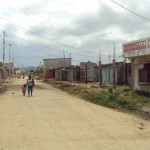Guayaquil, en un día
Buenos días from Ecuador! Melody and I have only been here for 3 days and yet have experienced so much. Yesterday we took a day trip to Guayaquil, Ecuador’s largest city at just under 3 million people, to visit the two clinics that Fundación Futuro runs there. One was in the southern neighborhood of Isla Trinitaria, while the other was in the more central neighborhood of Plan Piloto. The poverty in these parts of Guayaquil was striking, particularly in contrast to the flourishing city we had seen only a short car ride away.
- A view of northern Guayaquil
- The street of the Isla Trinitaria Clinic
In addition to getting to experience Fundación clinics for the first time, an especially important message I took away from today was something that Rocio, who showed us around all of the clinics, mentioned while waiting for our flight back to Quito. She emphasized that the reason these clinics are able to help the communities they serve as much as they do is because of the people that work there. Again and again when I asked why people chose to pay a small fee to receive care at the Fundación clinics rather than visit the free government clinics, I heard that the Fundación doctors take time to really talk to their patients and the care is much more personalized than at the busy government clinics. In settings where money is so scarce, the fact that patients are willing to pay even a small amount truly speaks to the quality of care provided.
Even during our short visit yesterday we saw and heard about many examples of workers going beyond their job expectations to help patients. In Isla Trinitaria, the outreach worker knows everyone in the area and is able to use these connections to make the clinic an integral part of its surroundings. The nurse is from the same neighborhood the clinic is in, and has an intimate knowledge of how the community functions. In Plan Piloto, patients visit the doctor with physical ailments, but also when they simply need someone to turn to. One of the women in the waiting room while we were there came to see the doctor because her sister had recently passed away and she was feeling sad. Another of the workers, who had been there the longest, had recently taken action when the grandmother of a family passed away, leaving her grandchildren in the care of their alcoholic father.
While I find these stories of workers who truly make their clinic impactful inspiring, and admire the ability of these clinics to have such a close relationship with their communities, I also worry about other clinics. Having such connected nurses, doctors and outreach workers is never a given, but they can factor heavily in the level of impact a clinic on a community. Is there any way to ensure that clinics form the sort of connection with their surroundings that we saw in the Guayaquil?
I certainly don’t have an answer to this, but I do think that technology can play an important role here. The less time a nurse or a doctor has to worry about the equipment they’re using, the more they can spend focusing on the patient. It may be hard to ensure that clinics become an integral part of their community, but BTB technologies can help give them the opportunity to do so by providing devices that work in their setting and allow them to provide the best care possible.
We’re scheduled to visit another Fundación clinic tomorrow, in the more rural setting of Yatzaputzan. I’m excited to see more of the work Fundación has done, and explore just how the BTB technologies can fit into their work.



